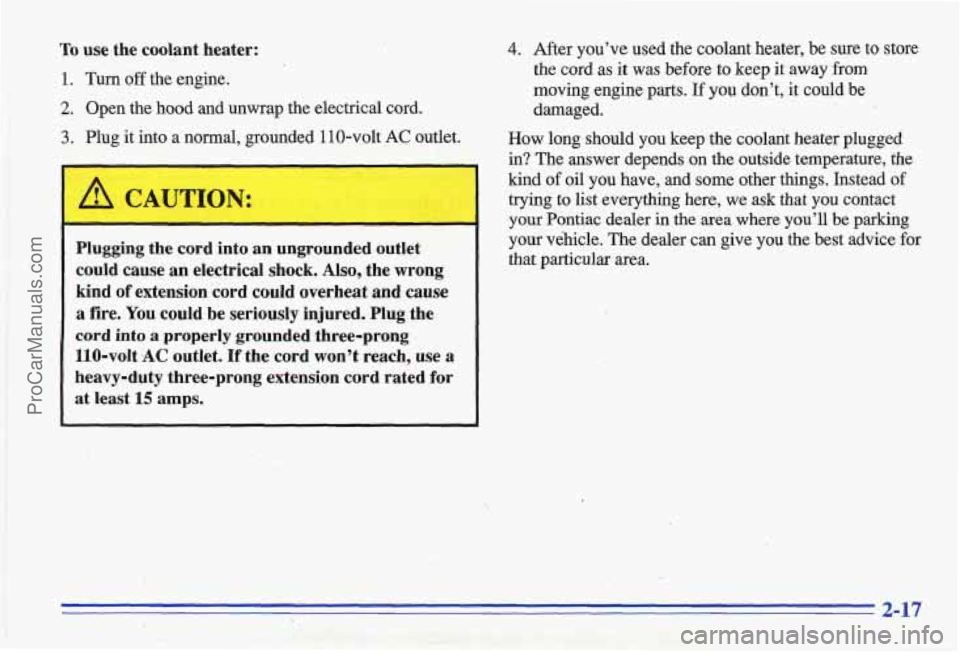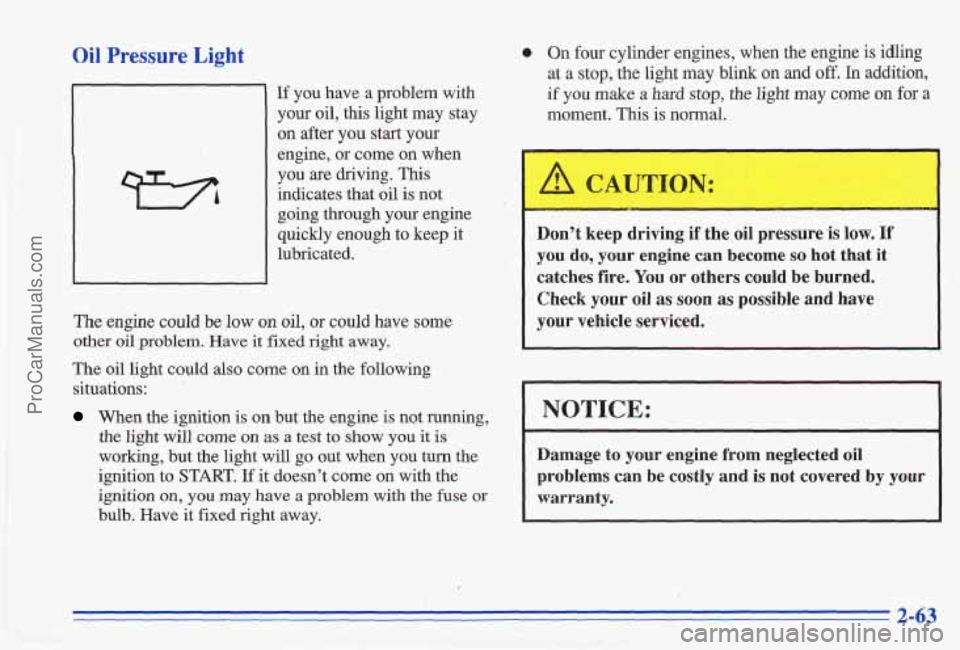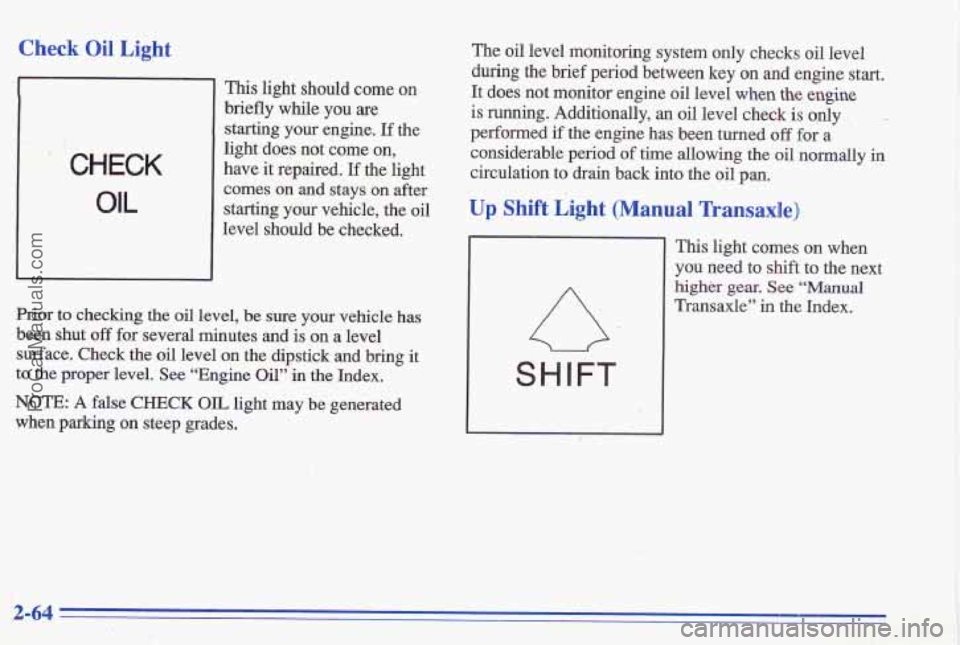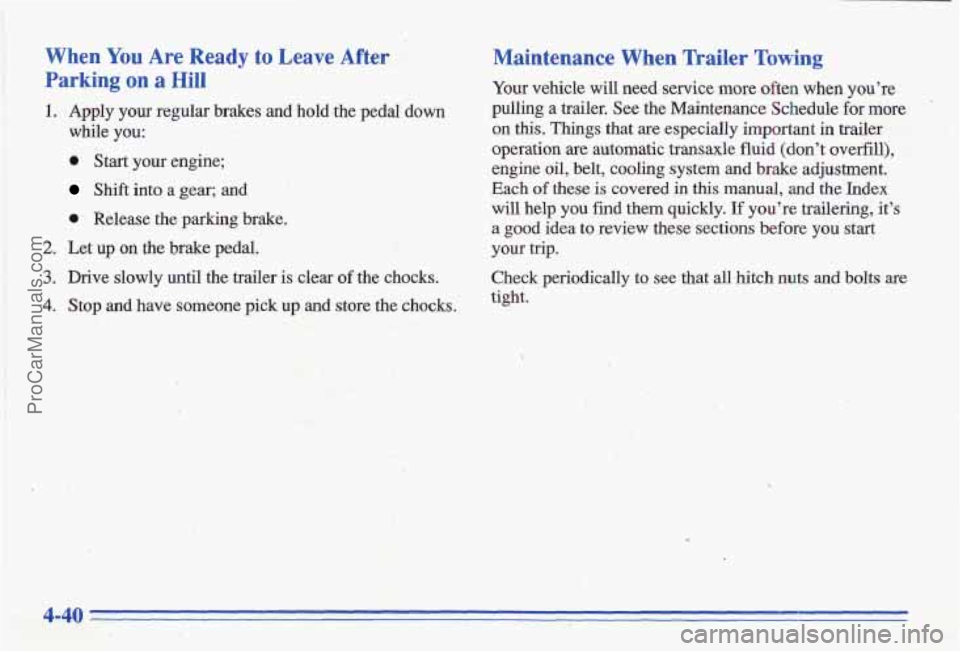Page 7 of 356
For example,
these symbols
me used on an
original battery:
POSSIBLE A
CAUTION
INJURY
PROTECT EYES BY
SHIELDING
CAUSTIC
ACID COULD BAllERY
CAUSE
BURNS
AVOID
SPARKS OR FLAMES
FLAME
EXPLODE BAllERY
These symbols
are important
for you and
yorr passengers
whenever your
vehicle is
driven:
DOOR LOCK
UNLOCK
FASTEN SEAT
BELTS
Vehicle Symbols
These are some of the symbols you may find on your vehicle.
Op
AIR BAG p
These symbols
have
to do with
your lights:
SIGNALS e
TURN
PARKING
pf
LAMPS
RUNNING
' ' 0
DAYTIME *
LAMPS *
FOG LAMPS $0
These symbols
are
on some of
your controls:
WINDSHIELD
DEFROSTER
WINDOW
DEFOGGER
VENTILATING FAN
These symbols are used on
warning and
indicator lights:
ENGINE k
COOLANT - rd
TEMP -
BRAKE (0)
ENGINE OIL
PRESSURE
ANTI-LOCK
(e)
BRAKES
Here are some
other symbols
you may
see:
FUSE
LIGHTER
m
HORN )tr
SPEAKER
b
il'
FUEL
V
ProCarManuals.com
Page 73 of 356

To use the coolant heater:
1. Turn off the engine.
2. Open the hood and unwrap the electrical cord.
3. Plug it into a normal, grounded 110-volt AC outlet.
1 A CAUTION:
Plugging the cord into an ungrounded outlet
could cause an electrical ,shock. Also, the wrong
kind
of extension cord could overheat and cause
a fire. You could be seriously injured. Plug the
cord into
a properly grounded three-prong
110-volt
AC outlet. If the cord won't reach, use a
heavy-duty three-prong extension cord rated for
at least 15 amps.
,-.. . . . 4.8 ..
4. After you've used the coolant heater, be sure to store
the cord as it was before
to keep it away from
moving engine parts. If you don't, it could be
damaged.
How long should you keep$he coolarit heater plugged
in? The answer depends on the outside temperature,
the
kind of oil you have, and some other things. Instead of
trying to list everything here, we
ask that you contact
yo" Pontiac dealer in the area where you'll be parking
your vehicle. The dealer can give you the best advice for
that particular area.
.. . i
ProCarManuals.com
Page 119 of 356

Oil Pressure Light
..
If you have a problem with your oil, this light may stay
on after you start your
engine,
or come on when
you are driving. This
indicates that oil is not
going through your engine
quickly enough to keep it
lubricated.
The engine could be low
on oil, or could have some
other oil problem. Have it fixed right away.
The oil light could also come on in the following
situations:
When the ignition is on but the engine is not running,
the light will come on as a test to show you it is
working, but the light will go out when you turn the
ignition to START. If it doesn’t come on with the
ignition
on, you may have a problem with the fuse or
bulb. Have it fixed right away.
0 On four cylinder engines, when the engine is idling
at
a stop, the light may blink on and off. In addition,
if you make a hard stop, the light may come on for a
moment. This is normal.
Don’t keep driving if the oil pressure is low.
If
you do, your engine can become so hot that it
catches fire. You or others could be burned.
Check your oil
as soon as possible and have
your vehicle serviced.
I NOTICE:
Damage to your engine from neglected oil
problems can be costly and
is not covered by your
warranty,
2-63
ProCarManuals.com
Page 120 of 356

Check Oil Light
. CHECK
OIL
This light should come on
briefly while you
are
starting your engine. If the
light does not come on,
have
it repaired. If the light
comes on and stays
on after
starting your vehicle, the oil
level should be checked.
Prior to checking the
oil level, be sure your vehicle has
been shut off for several minutes and is on a level
surface. Check the oil level on the dipstick and
bring it
to the proper level. See “Engine
Oil” in the Index.
NOTE: A false CHECK OIL light may be generated
when parking
on steep grades. The
oil level monitoring system only checks
oil level
during the brief period between key
on and engine start.
It does not monitor engine
oil level when the engine
is running. Additionally, an oil level check is only
performed
if the engine has been turned off for a
considerable period
of time allowing the oil normally in
circulation
to drain back into the oil pan.
Up Shift Light (Manual Transaxle)
This light comes on when
you need to shift to the next
higher gear. See
“Manual
Transaxle” in the Index,
2-64
ProCarManuals.com
Page 170 of 356

The exit speed is usually posted.
Reduce your speed according
to your speedometer, not
to your sense of motion. After
driving for any distance
at higher speeds, you may tend to think you are going
slower than you actually are.
Before Leaving on a Long Trip
Make sure you’re ready. Try to be well rested. If you
must
start when you’re not fresh -- such as after a day’s
work
-- don’t plan to make too many miles that first part
of the journey. Weax comfortable clothing and shoes you
can easily drive in.
Is your vehicle ready for a long trip? If you keep it
serviced and maintained, it’s ready to
go. If it needs
service, have it done before
starting out. Of course,
you’ll find experienced and
able service experts in
Pontiac dealerships all across North America. They’ll be
ready and willing to help
if you. need it. Here are some things
you can check before a trip:
WindshieZd Washer Fluid: Is the reservoir
full? Are
all windows clean inside and outside?
Wiper Blades: Are they in good shape?
Fuel, Engine Oil, Other Fluids: Have you checked
Lamps: Are they all working? Are the lenses clean?
‘Tires: They are vitally important to a safe,
all levels?
trouble-free
trip. Is the tread good enough for
long-distance driving? Are the tires all inflated
to the
‘ recommended pressure?
Weather Forecasts: What’s the weather outlook
along your route? Should you delay your trip a short
time to avoid a major
storm system?
Maps: Do you have up-to-date maps?
4-22
ProCarManuals.com
Page 188 of 356

When You Are Ready to Leave After
Parking on a Hill
1. Apply your regular brakes and hold,the pedal down
while
you:
0 Start your engine;
Shift into a gear; and
I. Release the parking brake.
2. Let up on the brake pedal..
3. Drive slowly until the trailer is clear of the chocks.
4. Stop and have someone pick up and store the chocks.
Maintenance When Trailer Towing
Your vehicle will need service more often when you're
pulling a trailer. See the Maintenance Schedule for more
on this. Things that are especially important in trailer
operation are automatic transaxle
fluid (don't ovel-fill),
engine oil, belt, cooling system and brake adjustment.
Each of these is covered in this manual, and the Index
will
help you find them quickly. If you're trailering, it's
a good idea to review these sections before you start
<* ~ I ,,; ;-':'. .a t , ,--: .. ;::l.$.:$ 5
Check periodically to see that all hitch nuts and bolts are
tight.
your trip. ! . .i . :$ ,,- .,,. . . f ~
_I.,
4-40
ProCarManuals.com
Page 205 of 356
' A CAUTION:
An electric fan under the hood can start up even
when the engine is not running and can injure
you. Keep hands, clothing and tools away from
any underhood electric
fan.
1
If tkie coolant inside the coolant surge tank is boiling,
don't
do anything else until it cools down.
The coolant level should be at or above FULL COLD. If
it isn't, you my have a leak in the radiator hoses, heater
hoses, radiator, water pump
or somewhere else in the
cooling system.
"I '!
_.
-. .
, :.' I' I1
ProCarManuals.com
Page 207 of 356
Adding only plain water to your cooling system
can be dangerous. 'Plain water, or
some other
liquid like alcohol, can boil before the proper
coolant
mix' will. Your vehicle's coolant warning
system is set
for the proper coolant mix. With
plain water
or the wroug mix, your engine could
get too hot but you wouldn't get the overheat
warning. Your engine could catch.fire and you
or
others could be burned. Use a 50150 mix of clean
water and
DEX-COOL TM antifreeze.
ProCarManuals.com